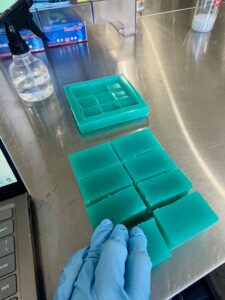Week 4: Watercolor Binder Solution, Pigment Planning, Silicone Molds
April 19, 2024
Welcome back to my blog!
This week has been primarily dedicated to preparations for the natural watercolor paints. I started off the week researching various methods for making a binder solution. Watercolor paint is essentially a mixture of finely ground pigment particles and a water-soluble binder, usually gum arabic (also known as gum acacia), which is the hardened sap of acacia trees. This combination allows the pigment to adhere to paper when water is applied, creating the characteristic translucent effect that watercolors have! To make the binder solution, I dissolved gum arabic in its powder form with warm distilled water, honey, vegetable glycerine (a humectant), and a few drops of eucalyptus oil. Adding a humectant makes the paint more fluid and the honey allows the paint to release its color onto a brush faster. Eucalyptus oil (eucalyptus globulus) contains compounds like eucalyptol that exhibit antimicrobial properties. This will help inhibit the growth of any bacteria or fungi.
Many manufacturers for commercial watercolor paints have transitioned to using synthetic pigments rather than natural ones, which poses significant environmental threats. Given this, I spent part of this week making a list of potential sources for different colors for the palette, which I plan to start gathering next week.
I also experimented with making silicone molds this week. While the process was enjoyable, the mold did not come out entirely as I had planned so I will be trying again next week.

Additionally, I tried making more spore prints out of king oyster mushrooms to bring to the lab next week for the agar plates. Unfortunately, my recent spore prints have been unsuccessful; the moisture content, humidity, and maturity of the mushroom may have contributed to this.
Reader Interactions
Comments
Leave a Reply
You must be logged in to post a comment.

It’s so interesting to watch your project continue to unfold, I’m curious what went wrong with the silicone molds?
We didn’t seal the container enough and it ended up leaking! The shape also did not have deep enough sections for what I had envisioned!
I wonder why manufacturers shift to synthetic paints. Is it cheaper? This project is so cool and I love the combination of creativity and STEM. Keep up the amazing work!